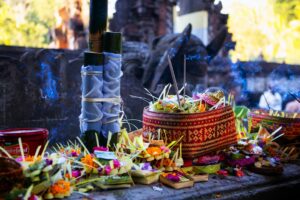The concept of rasa in Indian aesthetics is deeply rooted in ancient Indian philosophy and has been a subject of contemplation and exploration for centuries. The term “rasa” literally translates to “juice” or “essence,” and it is believed to be the essence of human emotions distilled and presented through artistic expression.
In Indian classical dance, music, and theater, the ultimate goal is to evoke a specific rasa in the audience. The artist strives to create a connection with the viewer, transporting them to a realm where emotions are heightened and experienced in their purest form. Through subtle movements, melodic compositions, and powerful dialogues, the artist aims to evoke a range of emotions such as love, joy, anger, compassion, and even fear.
According to Indian aesthetic theory, there are nine primary rasas: Shringara (love), Hasya (laughter), Karuna (compassion), Raudra (anger), Veera (courage), Bhayanaka (fear), Bibhatsa (disgust), Adbhuta (wonder), and Shanta (peace). Each rasa is associated with a specific set of emotions and has its own unique characteristics.
For example, Shringara rasa is associated with love, romance, and beauty. It is expressed through graceful movements, melodious music, and poetic lyrics. On the other hand, Raudra rasa represents anger and is characterized by vigorous movements, intense facial expressions, and powerful dialogues.
The concept of rasa goes beyond mere entertainment or aesthetic pleasure. It is believed to have a transformative effect on the audience, elevating their consciousness and providing a deeper understanding of human emotions and experiences. By experiencing different rasas, the audience is able to empathize with the characters on stage and gain a new perspective on life.
Moreover, rasa is not limited to the realm of performance arts. It is considered to be a fundamental aspect of everyday life and is believed to be present in all forms of artistic expression, be it visual arts, literature, or even architecture. The ability to evoke rasa is seen as the highest form of artistic achievement, and artists are revered for their ability to create a profound emotional impact on the audience.
In conclusion, the concept of rasa in Indian aesthetics is a profound and multi-faceted concept that explores the power of art to evoke and transcend human emotions. It is a testament to the rich cultural heritage of India and continues to be a source of inspiration and contemplation for artists and audiences alike.
Constituents of Rasa
Rasa is composed of several constituents that work together to create a profound emotional impact on the audience. These constituents are:
- Vibhava: Vibhava refers to the determinants or the causal factors that contribute to the creation of a particular emotion. It can be an external stimulus or an internal thought process that triggers a specific emotional response. For example, in a tragic play, the death of a loved one can serve as a vibhava that evokes feelings of grief and sorrow in the audience.
- Anubhava: Anubhava represents the visible or external manifestations of the emotions being portrayed. It includes facial expressions, bodily gestures, and other physical aspects that convey the emotional state of the characters or performers. These visible cues help the audience connect with the emotions being depicted on stage. For instance, a performer’s tears and trembling voice can be an anubhava that amplifies the audience’s experience of sadness or empathy.
- Sanchari Bhava: Sanchari Bhava refers to the transient or transitory emotions that arise as a result of the primary emotion being experienced. These secondary emotions further enhance the overall emotional experience of the audience. For instance, in a scene where a character is expressing anger, the audience may also experience fear or excitement as a result of the intense emotions being portrayed.
- Sthayi Bhava: Sthayi Bhava is the dominant or the permanent emotion that remains constant throughout the performance. It forms the foundation of the rasa and provides a sense of continuity and coherence to the overall emotional experience. This dominant emotion can vary depending on the theme of the performance. In a comedy, the sthayi bhava may be joy or amusement, while in a tragedy, it may be sadness or despair.
- Vibhavadi Bhava: Vibhavadi Bhava refers to the supporting emotions that complement the sthayi bhava. These emotions help to further develop and deepen the overall emotional experience of the audience. They can include emotions such as love, anger, fear, disgust, and more. For instance, in a romantic play, supporting emotions like desire, jealousy, or longing can complement the sthayi bhava of love.
One could argue that rasa is both internal and external, as it exists within the realm of the individual’s emotions and thoughts, yet it is also shared and experienced by others through the artist’s expression. In this sense, rasa can be seen as a bridge between the internal and external worlds, connecting the personal with the collective.
When an artist creates a piece of art, whether it be a painting, a dance performance, or a piece of music, they are essentially channeling their own emotions and experiences into their work. They transform their internal state into an external form that other people can see and understand by becoming a vessel through which the rasa flows.
However, the process of externalizing rasa is not as simple as it may seem. It requires a deep understanding of the chosen art form, as well as a mastery of the techniques and skills necessary to effectively convey the desired emotions. The artist must carefully select the appropriate gestures, colors, rhythms, or melodies that will evoke the intended rasa in the audience.
For example, in classical Indian dance, the dancer uses intricate hand gestures, facial expressions, and body movements to convey different emotions and rasa. Each movement is carefully choreographed to tell a story and elicit a specific emotional response from the viewers. The dancer’s training and expertise allow them to effectively externalize their internal experience of rasa, creating a powerful and transformative experience for both themselves and the audience.
Similarly, in traditional Japanese tea ceremonies, the host carefully selects and arranges the tea utensils, the flowers, and the space itself to create a harmonious and serene atmosphere. The goal is to evoke a sense of tranquility and inner peace in both the host and the guests. Through their meticulous attention to detail and their mindful presence, the host externalizes their internal state of calmness, inviting others to experience the same rasa.
In conclusion, rasa can be seen as a complex interplay between the internal and external worlds. It is a deeply personal and subjective experience that is brought to life through the artist’s expression. We can relate to and find meaning in an artist’s work when they are able to externalize their internal experience of rasa through dance, music, painting, or any other form of art.
Bharata’s Natya Shastra not only provides a framework for the creation and experience of rasa but also delves into the intricate details of its manifestation in different art forms. The treatise explores the concept of rasa from multiple perspectives, including the role of the performer, the audience, and the various elements of a performance.
One aspect that Bharata emphasizes is the importance of the performer’s skill and expertise in evoking rasa. He emphasizes the need for the artist to have a deep understanding of the emotional states associated with each rasa and the ability to convey them convincingly through their gestures, expressions, and vocal modulation. Bharata lays down specific guidelines for the training of artists, emphasizing the need for rigorous practice and mastery of the various techniques involved in the performance.
In addition to the performer’s skill, Bharata also recognizes the significance of the audience’s receptivity in the experience of rasa. He acknowledges that the audience’s emotional disposition and cultural background play a crucial role in their ability to connect with and appreciate the rasa being portrayed. Bharata suggests that the performer should be aware of the audience’s preferences and adapt their performance accordingly to create a more impactful experience.
Furthermore, Bharata’s Natya Shastra delves into the various elements that contribute to the overall aesthetic appeal of a performance. He provides detailed descriptions of the appropriate costumes, makeup, music, and dance movements that should be employed to enhance the portrayal of each rasa. Bharata believes that the harmonious integration of these elements not only enhances the visual and auditory experience but also deepens the emotional impact of the performance.
Additionally, Bharata introduces the idea of bhavas, which are the psychological and emotional states that the characters go through. He explains that the portrayal of bhavas is crucial in creating a meaningful and impactful performance. Bharata identifies eight primary bhavas, including love, laughter, compassion, anger, valor, fear, disgust, and wonder, each corresponding to a specific rasa. He provides detailed instructions on how to effectively portray these bhavas, including the appropriate facial expressions, body language, and vocal modulation.
Overall, Bharata’s Natya Shastra serves as a comprehensive guide for artists and enthusiasts alike, offering insights into the intricacies of rasa and its integration into various art forms. The treatise not only outlines the theoretical aspects of rasa but also provides practical guidance for its effective portrayal. It remains a significant influence in the field of performing arts, continuing to shape the understanding and exploration of rasa to this day.





















+ There are no comments
Add yours